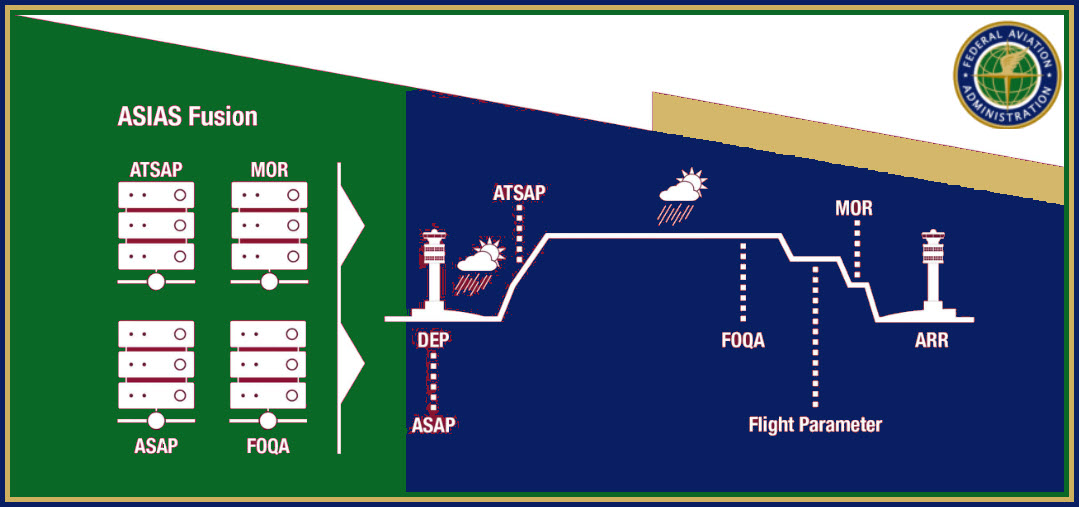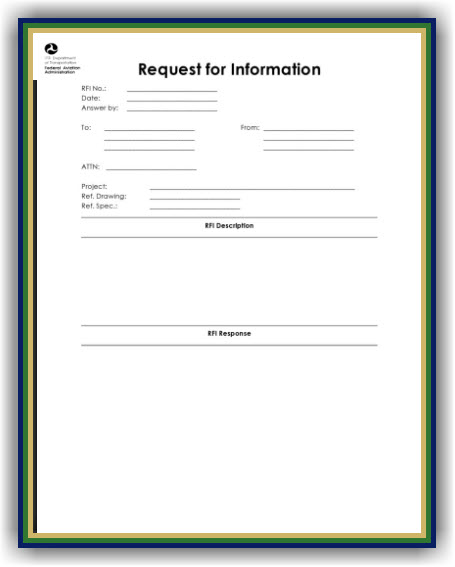FAA RFI for AI integration of Safety Data Sources with Predictive tools

The FAA recently issued a Market Survey/Request for Information (RFI) to integrate all of the various aviation systems, to use (develop) analytics that will project risks and provide supporting remedial action reference data. The notice also asks for available already available algorithms, software and hardware.
A DOT Inspector General, long, long, ago, labeled the FAA as a TOMBSTONE AGENCY, based on her opinion that the organization only raised its safety standards in response to a fatal aircraft crashes.

An enlightened FAA Associate Administrator took several bold actions to transition the retrospective perspective to prospective. The basic rubric for this new approach to risk reduction has been SAFETY MANAGEMENT SYSTEMS (SMS). Its current preventative analytics are driven by information gathering resources such as
· Flight Operational Quality Assurances (FOQA),
· Aviation Safety Action Program (ASAP),
· Aviation Safety Information Analysis and Sharing (ASIAS),
- Aviation Safety Reporting System (ASRS)
· Aircraft Certification Safety Review Process (ACSRP)
· Airport Voluntary Reporting System (AVRS)
- Air Traffic Safety Action Program – X (ATSAP-X)
- Federal Contract Tower Safety Action Program (SAFER-FCT)
- Technical Operations Safety Action Program (T-SAP)
- Voluntary Disclosure Reporting Program (VDRP)
- OTHERS???

From FedScoop—
“The posting comes as the agency has SLOWLY EXPLORED artificial intelligence applications and has disclosed several use cases as part of the Department of Transportation’s AI use case inventory.
Previous FedScoop reporting revealed myriad hurdles the FAA faces in trying to incorporate the technology, even as the Biden administration encourages an all-of-government effort to modernize systems using AI.
“Because aviation is a safety critical industry and domain, in general, stakeholders involved in this industry are slower to adapt AI models and tools for decision-making and prediction tasks,” Syed A.M. Shihab, an assistant professor of aeronautics and engineering at Kent State University, told FedScoop in April. “IT’S ALL GOOD WHEN THE AI MODEL IS PERFORMING WELL, BUT ALL IT TAKES IS ONE MISSED PREDICTION OR ONE INACCURATE CLASSIFICATION, CONCERNING THE USE CASES, TO COMPROMISE SAFETY OF FLIGHT OPERATIONS.”

The professor’s seemingly critical comment, “slower to adapt AI models”, seems contradictory to his recognition of the severe consequences of an AI error in projecting aviation safety trends. That point suggests the HORRENDOUS LIABILITY associated with the implementation of this contract proposal. To add to this risk, it is difficult to identify the nature and size of a calamity which might result from an AI error. Under such circumstances, the FAA might consider the possibility of Indemnification Under Public Law85-804 (FAR 52.250-1). The Administrative Conference of the United States has issued the following advice on the clocking of the awardee with essentially “sovereign immunity”:
“Indemnification of government contractors for third-party liability involves this issue: Who should bear the risk of liability for injury or damage to a third party caused by products and services supplied by government contractors? This issue is especially significant when the products and services involve high-risk or hazardous governmental activities.
The liability of the government is limited by the doctrine of sovereign immunity, which has been waived only in certain situations, such as the Federal Tort Claims Act… In the absence of insurance or indemnity, government contracts may be exposed to claims based, for example, on alleged failure to follow specifications or adequately warn the government or others about product design defects.”

Without such protection, the pool of potential bidders may be small. Today, the market of various SMS software providers is LARGE. None, however, appear to have experience integrating so many data streams and few have had to SECURELY link their hardware to multiple users.

+++++++++++++++++++
FAA wants industry input on use of AI in aviation safety

MARKET SURVEY/ REQUEST FOR INFORMATION
This Market Survey/Request for Information (RFI) is being issued in accordance with the Federal Aviation Administration (FAA) Acquisition Management System (AMS) Policy 3.2.1.2.1.
I. PURPOSE
This Market Survey/RFI seeks to identify EXISTING CAPABILITIES for advanced analytics using modern ARTIFICIAL INTELLIGENCE (AI) capabilities to improve aviation safety within the industry and meet the FAA’s requirements for UNDERSTANDING UNDERLYING CAUSAL FACTORS for top safety events in the National Airspace System (NAS).
The purpose of this Market Survey/RFI is to:
- Inform Industry of the FAA’s objectives for leveraging AI to enhance aviation safety and solicit Industry feedback.
- Assess market interest and existing industry capabilities to provide advanced safety analytics solutions.
- Determine the degree of customization required to integrate existing industry analytics capabilities into the FAA infrastructure.
- Obtain feedback from Industry on risks, considerations, and other related feedback on improving aviation safety analytics.
II. CURRENT FAA SAFETY ANALYTICS SYSTEMS
Currently, the FAA has internal capabilities such as the AVIATION SAFETY INFORMATION ANALYSIS AND SHARING (ASIAS) system and other bespoke systems. These capabilities constitute an extensive collection of connected and disconnected systems. These systems are utilized for SAFETY INFORMATION ANALYSIS and SHARING ACROSS VARIOUS AVIATION STAKEHOLDERS, helping to MONITOR AND IMPROVE SAFETY STANDARDS within the NAS.

III. SAFETY ANALYTICS END STATE OBJECTIVES
The FAA ENVISIONS a new safety analytics system that will VASTLY EXPAND AND ACCELERATE INSIGHTS from current and additional sources of data and provide a comprehensive understanding of causal factors of safety events to help predict high-risk operations and environments. The end state will be built on commercially available analytics tools that are widely used by a substantial number of companies and organizations to make similar improvements to the safety of operations or to reduce mistakes in operations.
The FAA aims to:
- ENHANCE PREDICTIVE ANALYTICS CAPABILITIES to identify and mitigate potential safety risks proactively.
- Leverage AI and machine learning to analyze vast amounts of safety data and derive actionable insights.
- Integrate various data sources to provide a comprehensive view of aviation safety factors.
- Improve the overall safety of the NAS through advanced analytics and rapid response to identified risks.
IV. CONSTRAINTS/CHALLENGES
The new safety analytics system requires integration into the existing FAA infrastructure, accounting for FAA safety, security, and integration processes. Key constraints and challenges include:
- DATA SENSITIVITY: Insights often come from data falling into protected categories (proprietary, PII, security-sensitive, etc.).
- DATA VARIETY: The data comes from various sources, is not standardized, and may have quality issues.
- INTEGRATION: Ensuring seamless integration with existing FAA systems and compliance with all relevant regulatory and security requirements.
- TIME TO INSIGHTS: Having the ability to empower users to transform data sets with minimal use of code or through derived insights.

V. REQUEST FOR CAPABILITY STATEMENT
The FAA requests the following information from interested vendors:
- Capability Statement that demonstrates the vendor’s ability and experience in implementing advanced predictive analytics and AI solutions for safety improvements.
- Description of current solution capabilities and how they meet the FAA’s end state objectives for aviation safety analytics.
- Explanation of any required changes to vendor’s solutions and the timeline to deploy these changes to meet FAA’s objectives.
- Describe vendor’s ability to leverage a Commercial-off-the-Shelf (COTS) Software-as-a-Service (SaaS) / Platform-as-a-Service (PaaS) solution to satisfy the FAA’s end state.
- Detailed information on the vendor’s ability to manage and analyze sensitive and varied data sources.
- Explanation of how data is accessed by others, how data sets are integrated on vendor’s platform, and how data is queried outside the application.
- Discussion of any assumptions or constraints considered in the capability response.
- Performance and scalability requirements supported by the system, including limitations such as the number of concurrent users and processing time for data transformations.
- RISK MITIGATION approaches that the Government should consider for this effort, including any innovative methods to support an accelerated schedule to achieve the objectives.
- Discussion of willingness to partner or work with other industry experts to enhance analysis.
- Discussion of the most critical safety events that may be impacted by the capabilities described in the response.
VI. SUBMISSION DETAILS
Interested parties must provide their responses in writing. Responses must be no more than 15 standard 8.5 X 11 pages long, single spaced, 12-point Times New Roman, and must be in MS Word format. Please limit company background information to one page.
The FAA may request one-on-one discussions in which respondents to this Market Survey may be invited to discuss their responses in more detail. Participation, if contacted, is voluntary but would be appreciated. Proprietary or confidential information contained in the Market Survey submissions must be appropriately marked.
Responses must be submitted electronically no later than 5:00 pm EDT on July 2nd, 2024, to the Contracting Officer at SafetyDataChallenge@faa.gov.
Disclaimer:
This is a Market Survey/RFI for informational purposes. The FAA will use responses to this Market Survey/RFI, along with any other information gathered or currently available to select the participants for the Analytics for Safety of the NAS Challenge. The FAA will select Participants based on its review of the participants capabilities and their perceived benefit to NAS safety. The FAA is not seeking or accepting unsolicited proposals. The FAA may request additional information or submissions, or request discussions or in-person meetings in furtherance of the market survey/RFI. The FAA will not pay for any information received or costs incurred in preparing responses to this market survey/RFI. Any costs associated with the market survey/RFI submittal, including the initial submission and any subsequent submissions, discussions, or in-person meetings, if requested by the FAA, are solely at the interested vendor’s expense.
This market survey/RFI is not a Screening Information Request (SIR), solicitation, or request for offer (SFO or RFO). No commitment or implied agreement will arise as a result of responding to the market survey/RFI. Submission to this market survey/RFI does not guarantee eligibility or impart a requirement for the market research participant to participate in or receive a SIR, SFO, RFO, or a contract. Consistent with AMS 3.2.1.2.1, the information obtained as a result of the market survey may refine a future acquisition strategy. Any future acquisition strategy may be implemented without public notice unless required by AMS.
Note: The FAR references cited in SAM.gov are not applicable to the Federal Aviation Administration (FAA) as the FAA has its own policies and guidance referenced in the Acquisition Management System (AMS).

XXXXXXXXXXXXXXXXXX